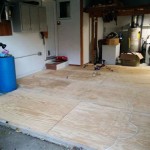How To Refinish A Concrete Garage Floor
A concrete garage floor endures significant wear and tear, from vehicle traffic and chemical spills to temperature fluctuations and moisture. Refinishing a concrete garage floor not only enhances its aesthetic appeal but also improves its durability, resistance to stains, and overall longevity. This guide provides a comprehensive overview of the process, detailing the necessary steps and materials for successful refinishing.
1. Preparation: The Foundation of a Successful Finish
Thorough preparation is paramount to achieving a professional-looking and long-lasting finish. This stage involves cleaning the floor, repairing any cracks or damage, and creating a suitable surface for the chosen coating to adhere properly.
Begin by clearing the garage of all items, including vehicles and storage. Sweep the floor thoroughly to remove loose debris, dust, and dirt. A more intensive cleaning may be required depending on the floor's condition. This can include degreasing with a specialized concrete cleaner and using a pressure washer to remove deeply embedded grime. A stiff-bristled brush can further assist in removing stubborn dirt and loose concrete.
Next, assess the floor for any cracks, chips, or other damage. Minor cracks can be repaired using a concrete patching compound, following the manufacturer's instructions. Larger cracks or spalling may require professional repair to ensure structural integrity. Allow ample drying time for any repairs before proceeding.
Finally, etching the concrete improves the adhesion of the chosen coating. This process involves applying an acidic solution to the concrete surface, which creates microscopic pores that allow the coating to bond more effectively. Follow the manufacturer's instructions carefully, ensuring proper ventilation and safety precautions.
2. Coating Selection: Choosing the Right Product for Your Needs
Selecting the appropriate coating depends on various factors, including the desired aesthetic, budget, and the level of durability required. Several options are available, each with its own advantages and disadvantages.
Epoxy coatings are known for their exceptional durability, chemical resistance, and glossy finish. They are ideal for garages subjected to heavy use and frequent chemical spills. Epoxy coatings come in two parts – a resin and a hardener – that must be mixed before application.
Acrylic sealers are less expensive than epoxy but offer good protection against stains and moisture. They are easier to apply and dry faster than epoxy, making them a suitable option for DIY projects. Acrylic sealers are available in various finishes, from matte to high-gloss.
Polyurethane coatings offer excellent abrasion resistance and are suitable for high-traffic areas. They provide a durable, glossy finish and are resistant to chemicals and UV rays.
Concrete stains penetrate the concrete surface, creating a permanent color that won't peel or chip. They are available in a wide range of colors and can be used to create decorative effects. However, concrete stains offer less protection against stains and wear compared to sealers or coatings.
3. Application: Achieving a Smooth and Even Finish
Proper application techniques are crucial for achieving a smooth, even, and professional-looking finish. Regardless of the chosen coating, follow the manufacturer's instructions carefully for optimal results.
Before applying the coating, ensure the floor is completely dry and free of dust or debris. If using a two-part epoxy, mix the resin and hardener thoroughly according to the manufacturer's instructions. Apply the coating using a roller or sprayer, working in manageable sections to avoid premature drying. Maintain a wet edge to prevent lap marks.
Depending on the chosen coating, multiple coats may be necessary to achieve the desired thickness and durability. Allow each coat to dry completely before applying the next, following the manufacturer's recommended drying times. Maintaining proper ventilation during application and drying is essential for both safety and achieving a uniform finish.
For epoxy coatings, consider adding anti-slip additives to enhance safety. These additives create a textured surface that improves traction, especially when the floor is wet.
Once the final coat has dried completely, allow ample curing time before subjecting the floor to heavy traffic or placing items back in the garage. The curing time varies depending on the chosen coating and ambient temperature. Consult the manufacturer's instructions for specific curing time recommendations.

1 Garage Flooring Coatings Ohio Get Your Perfect

Refinishing Options For Older Concrete Floors

Epic Garage Transformation How To A Floor

Painting Your Garage Floors Do S Dont Making Pretty Spaces Blog

Garage Floor Resurfacing The Best In Concrete Restoration

Refinishing Garage Floor Your1dayfloor

The Best Garage Floor Finishes Paint Tile More

How To Paint A Garage Floor Clean And Scentsible

Everything You Need To Know About Concrete Floor Resurfacing Blog

Signs You Need To Refinish Your Garage Flooring Memphis Coatings Company
Related Posts








